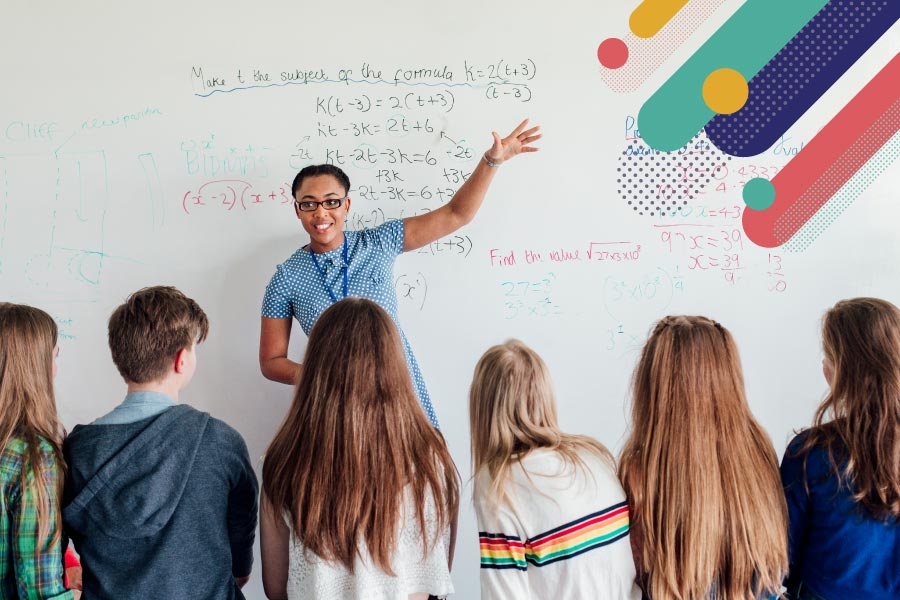Veteran teacher Sara outlines strategies to help your students improve their confidence in math and offers tips she uses in her class to promote a positive learning environment where students are given the opportunity to demonstrate what they know.

Teaching math can be challenging, especially when students have low confidence in their mathematical abilities. Here are some strategies I have developed over the years to help build student confidence and make teaching math a more pleasant and productive experience. Try them in your classroom!
Identify Strengths and Challenges
Identifying student strengths and challenges helps set the stage for a positive environment in my math class. Once my class list is finalized, I review student records to gain insight into classroom composition, especially at the beginning of the year as I’m getting to know students.
At my school I have access to district mathematics assessment data and I look for general trends from previous grades. This helps inform my instruction for the upcoming year. For example, if I see that a large portion of students previously had difficulty in geometry, I expect to encounter challenges when I teach this unit. I can then adapt my instruction and conduct a more in-depth review before starting the unit and be extra diligent checking for understanding as the unit progresses.
Activate Prior Knowledge
Most mathematics curriculum is a spiral where topics are revisited and built upon.
I attempt to help students feel comfortable and boost their mathematical confidence by activating their prior knowledge, reminding them that they already know some key aspects of our topics.
This can be accomplished formally using KWL charts, which you can find on TeacherVision. In addition to KWL charts, or if I am running short on time, I often do a class brainstorm session on the board when introducing a new topic. I find it useful to ask students what they know, remember, or think of when they hear a certain topic and encourage them to volunteer anything that comes to mind, whether it’s a word, phrase, or diagram.
Some students will give detailed answers, such as “the equation of a line is y = mx + b.” Others may provide a short yet pertinent answer, such as “graphs” or “straight line,” which sparks a class discussion, validating that the student who answered knows something about the topic and reminding the class that they have seen this before.
Informed Instruction
Exit tickets are an important tool in math class as they have the potential to reveal concepts requiring additional practice before summative assessments occur. Exit tickets can be a quick way to check in with students and gauge their understanding. Simple rating-scale tickets are very effective: “On a scale of 1 (confused) to 4 (got it) rate your understanding of dividing fractions.” This type of exit ticket is quick and easy for a teacher to tally yet provides valuable information to inform further instruction. If the vast majority of the class replies that they have a good understanding of the topic, the teacher may move on. However, if the majority of the class responds that they are still having difficulties, the teacher can plan next steps to address this.
Another type of exit ticket may ask students to identify what they found most confusing in today’s lesson. This is another useful type of question to guide instruction – if the majority of the class gives the same response, there is a need to revisit the topic.
I also do quick informal surveys of my class during lessons. I ask everyone to put their heads down, and then ask students to raise their hands if they 1) feel they are understanding the topic, or 2) are still confused. Making this an anonymous survey, by putting their heads down, helps to remove anxiety and encourages students to answer truthfully. It also lets me know who may need a check-in before the lesson is over and lets me adapt my instruction on the spot, providing more explanation or moving on as required.
Differentiated Instruction
Differentiated instruction helps students to succeed in math class because it meets them at their mathematical level. To differentiate instruction, start the whole class with the same lesson. The differentiating comes in when it is time for students to apply and practice what they have learned. I provide questions to students based on their ability, grouping students who, through the use of exit tickets or surveys, have indicated similar understanding of the subject up to this point.
For example, I may group students who have indicated on an exit ticket a strong understanding of the topic together with a set of more challenging questions. Another group, who has indicated they are developing an understanding of the topic, will be given a mix of simple and complex questions. And I will work directly with students who have indicated they find the topic challenging. This of course takes a bit of planning and organizing to implement.
Another way to differentiate instruction in math class is to provide and encourage the use of open-ended questions.
For example, rather than giving students a dividing fractions worksheet, you may ask students to create five of their own fraction division questions, with answers. Using this method, students can demonstrate what they know about dividing fractions. For example, some may use a combination of mixed numbers, improper fractions, different denominators etc. Others may use only fraction benchmarks (½, ¼, etc.). Regardless of the fractions they choose to include, each student is meeting the outcome of dividing fractions.
Show What They Know
Going along with the point above, I try to provide students with the opportunity to show me what they know about math. As mentioned, open-ended questions are one method of doing this. Using a variety of formative and summative assessments, such as observations, conversations and a range of products (concrete, pictorial, or symbolic) is another way to incorporate student choice and the opportunity to demonstrate what they know into your lessons.
Some of the alternate formative assessments I use include Frayer models, questions without numbers, and “bad” examples. Giving “bad” examples especially seems to be a favorite of students. For example, I may ask them for a bad example of applying the order of operations to rational numbers, or finding the area of a circle. I ask them to list 3-5 points that explain why their example is “bad” and what would make their answer “good.”
Asking for bad examples appears to remove the pressure of giving the perfect answer and encourages students, who may otherwise be reluctant, to attempt the problem.
Providing students with these opportunities to demonstrate what they know helps them gain confidence in their mathematical ability.
I feel one of our biggest challenges in math class are students who doubt their own mathematical skills. Focusing on what students know, checking for understanding and adapting instruction as necessary to meet my students where they are helps develop a positive learning environment in my classroom and helps students experience success. I hope you are able to use some of these strategies in your own class to get to know your students and boost their mathematical confidence.
What are your strategies for teaching math effectively? Share with us on Instagram, Facebook, Twitter, and Pinterest.
Veteran teacher Sara McCarthy has been teaching middle and high school math and science in Nova Scotia, Canada for the past ten years. She has recently started Escape Ed, which produces educational games for math and science classes. Before becoming a teacher, Sara worked in a molecular biology lab where she honed her mad scientist skills. She spends her winter breaks on ski slopes and her summers at the beach.










